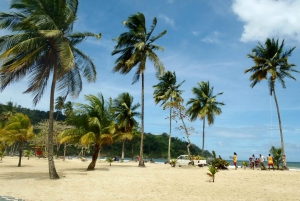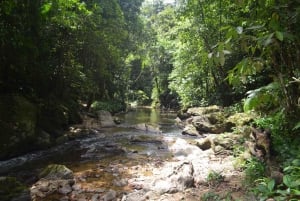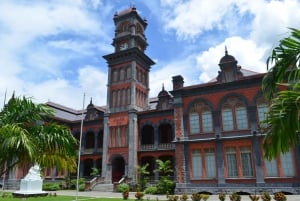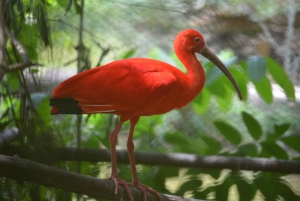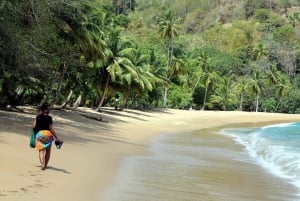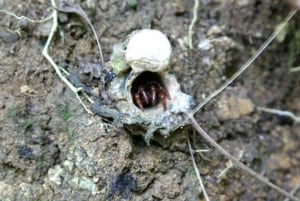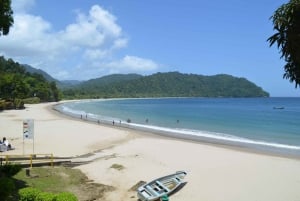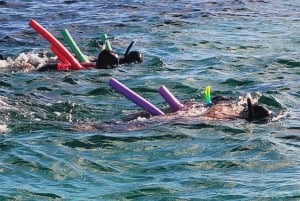Carnival
Carnival in Trinidad and Tobago is one of grandeur, colour, revelry and rhythm. Evolving over the past two centuries from an elegant, exclusive affair to a truly all-inclusive national festival, it is by far the most spectacular event on the nation’s calendar. Although a major part of the Trinidad Carnival mystique lies in its unique ability to bring people of diverse backgrounds together in harmonious circumstances, the festival was not born to such noble pursuits.
The Carnival celebrations between 1783 and 1838 were dominated by the white elite. Africans and coloureds (persons of mixed race) were forbidden by law to participate in street festivities. This is not to say that they did not celebrate in their own way in their compounds. During this period also, there were numerous balls, parties and other entertainment. This gave the Africans some measure of freedom to enjoy themselves and engage in merry making. These festivities, along with the pomp and ceremony involved in imposing martial law, provided the Africans with ideas for some of the earliest masquerades for Carnival.
In this era, the period between Christmas and Lent was marked by great merrymaking and feasting by both the French and English. Historians of the nineteenth century wrote about the balls, fetes champetres (country style parties) and house to house visiting engaged in by the white upper class. It was also the custom of the British to impose martial law during the Christmas season. Military exercises were performed at the start of this martial law.
The pre-emancipation Carnival saw whites costume themselves as Negues Jadin (Negres Jardin - French for Garden Negroes) and mulatresses. They also reenacted the Cannes Brulées (French for Burning Canes): the practice of rounding up slaves to put out fires in the cane field. With the emancipation of the slaves in 1838, however, the door was opened for the full participation of the Africans in the Carnival.
After having withdrawn from the celebrations for most of the latter half of the nineteenth century the first two decades of the twentieth century marked the gradual re-entry of the upper classes of Trinidad’s society into the festival. Carnival took on a more organized and European character. Fancy dress balls were held at the Princes Building opposite From the 1920s straight until 1948 carnival saw increased participation by the various ethnic groups and classes in Trinidad and Tobago society. The private sector also became involved, organizing competitions and sponsoring prizes. The annual masquerade ball organized by the Society of Les Amantes De Jesus, required a change from a ball to a stage spectacle and an attempt to weave together all the main strands of Carnival – dance, costume and characters into one event was made.
Carnival in Trinidad and Tobago was banned during World War II (1939-1945) for security reasons, but since the 1950s it has evolved into a huge celebration with thousands of revelers coming together in processions, music, and dance.
Today Carnival in Port of Spain is known as mas, an abbreviation for mask or masquerade. Ironically, few participants wear masks but their costumes convey a variety of themes. The majority of revelers pay to join one of the larger organized groups called Mas bands, whose fanciful outfits change from year to year. Some of the smaller groups and individuals prefer to play traditional mas, donning the masquerades that evolved in the late 19th and early 20th centuries.
Individuals wearing devil masquerades began to appear in Port of Spain Carnival in the late 19th century. By the 1920s they were organized into large groups with a number of different representations ranging from simple devils to more elaborate "rulers" who wore large papier-mâché masks and ornate costumes with capes. The "rulers" went by such names as Satin, Lucifer, and the Bookman who carried a book to record the sins of the people of Trinidad.
Masqueraders portraying British navy men appeared in Port of Spain Carnival throughout the 19th century, but a visit by the United States Atlantic fleet in 1907 started a new phase of imitating "Yankee Sailors." Further inspiration came during World War II when Americans set up a naval base near the city. Today many masqueraders wear simple navy uniforms of white pants, shirts, and hats. Fancy Sailors, distinguish themselves with more elaborate headgear, decorating their costumes with medallions, ribbons, rosettes, braiding, and other embellishments. Among the Fancy Sailors are the Stokers, who push long iron rods in front of them while shuffling forward in the Fireman's dance.
Carnival in Port of Spain annually attracts thousands of participants who pay to”play” in one of the variety of Carnival bands. Each year carnival bandleaders select themes for their costumes that range from historical events, to ethnic heritage, to pure fantasy. The latter category has become increasingly popular in recent years as liberated women want to show off their bodies. Many costume designers embrace the idea that less is more and express the fantasy theme through skimpy outfits ornamented with strings of beads and feathers.
On Carnival Monday and Tuesday, many mas bands are in competition to win the Band of the Year title. While others are about masquerader enjoyment and avoid all competitions. Participation occurs at all levels of society and children have their own version of carnival and participate from as early as parents can get them into costume; sometime even strollers are decorated.
Today, Carnival is Trinidad and Tobago’s main tourist attraction and has inspired several Carnivals in cities where citizens of Trinidad and Tobago have settled, including New York, Toronto, Miami and London. Other Caribbean Islands such as Jamaica, St.Vincent and Grenada have similar festivities but Trinidad and Tobago Carnival remains the greatest show on earth.




